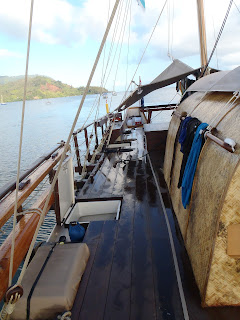Thursday, April 26, 2012
A Brief Tour of the Waka
Let me introduce you to the wakas (canoes). There are seven all together: Haunui, Te Matau A Maui, Hinemoana, Marumaru Atua, Uto Ni Yalo, Gaualofa and Faafaite. All were built in New Zealand, based on the design of a Cook Islands waka, Te Au O Tonga, that was built for the 1995 voyage to Raiatea and the Marquesas. The wakas are 72' long and double-hulled. In the last photo, you can see the hatches that open into the hulls. Each hull contains "shelving" along both sides: the top shelves are bunks with mattresses, and the bottom shelves are for food, supplies and gear storage (I didn't take any interior pictures before, so none to post). This is different from Hokule'a in that we sleep on top of our hulls (under a canvas cover, though). The hulls of these waka are deep enough that I can stand upright in them. By the way, the picture of the full waka is Haunui, the one I will be on, and the rest of the pictures are from other waka. They're all set up the same, though. The hale on the deck contains two important areas. On the bow (forward) side is the bathroom (the door in the wide shot of the hale). Yes, there IS a toilet, although it requires the user to get a bucket of water to flush it. The back side (see photo) is the captain's area as well as the galley (kitchen). There's a small table with benches, as well as the electronics center of the waka. The galley has a full stove with an oven! Now that's a real luxury compared to the propane stoves I'm used to on Hokule'a.
One aspect of these waka that is unique is their solar-powered engines. They are on brackets under the deck that unfold into the water for use, and fold back up for storage. You can see the propellers in the picture of the stern (rear) of the waka. I believe the capacity of the solar battery allows the engines to run for 5 hours at 5 knots without recharging. However, the purpose of a waka is to be SAILED, and so each waka has two masts, for two sails. They carry two different sets of sails as well; one, as you see in the picture, is decorated and is for ceremonial purposes, although they definitely work well! These waka are very fast, and can average 9-10 knots an hour in good wind (a knot is a nautical mile and is equal to 1.1 miles over land). The TOP speed recorded (going down a swell in very strong winds was something like 25 knots. Like any waka, however, if there is NO wind, your choices are to run the engines or drift with the tides.
Because each waka is affiliated with a Polynesian island group, the main parts of the wakas have names given to them that represent their culture. On Hokule'a, for example, the mast steps and sweeps (steering paddles) are given the names of people who were foundational to her success. I look forward to learning more about Haunui and sharing her names with you. What I know now is that the waka was names for John Haunui who was instrumental in supporting this project in New Zealand. You can read more about that on the Pacific Voyagers website.
What's exciting to me about the upcoming part of this voyage is that I will see each waka in its home, and see each crew come home to much deserved recognition and celebration in their islands. having known some of the crew from years past, and gotten to know much more of the crew over the last year, it will be extra special!
Subscribe to:
Post Comments (Atom)





No comments:
Post a Comment